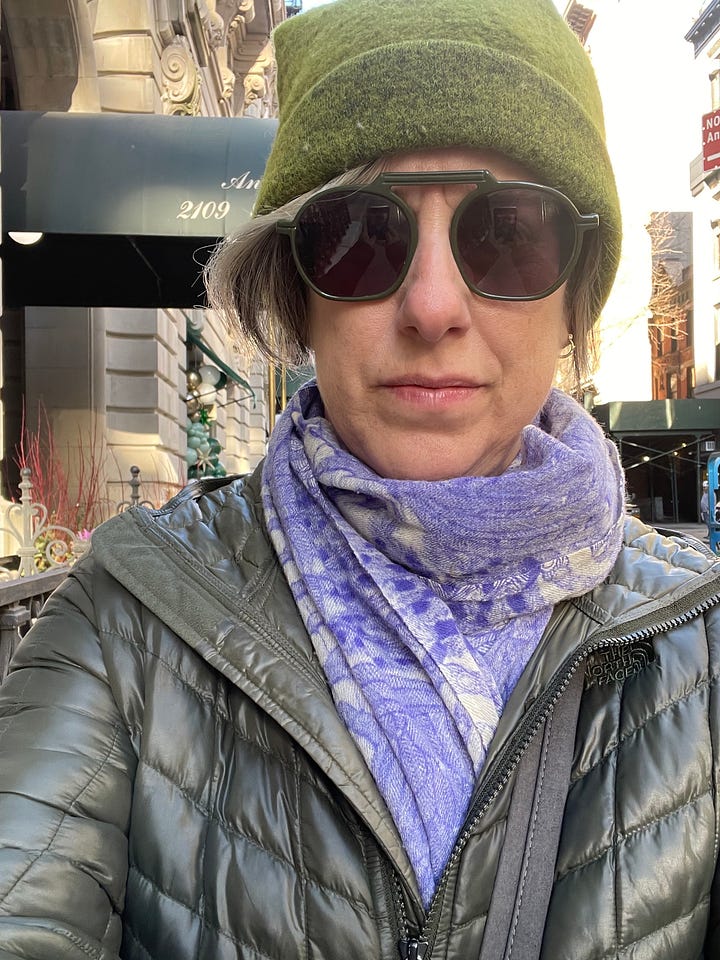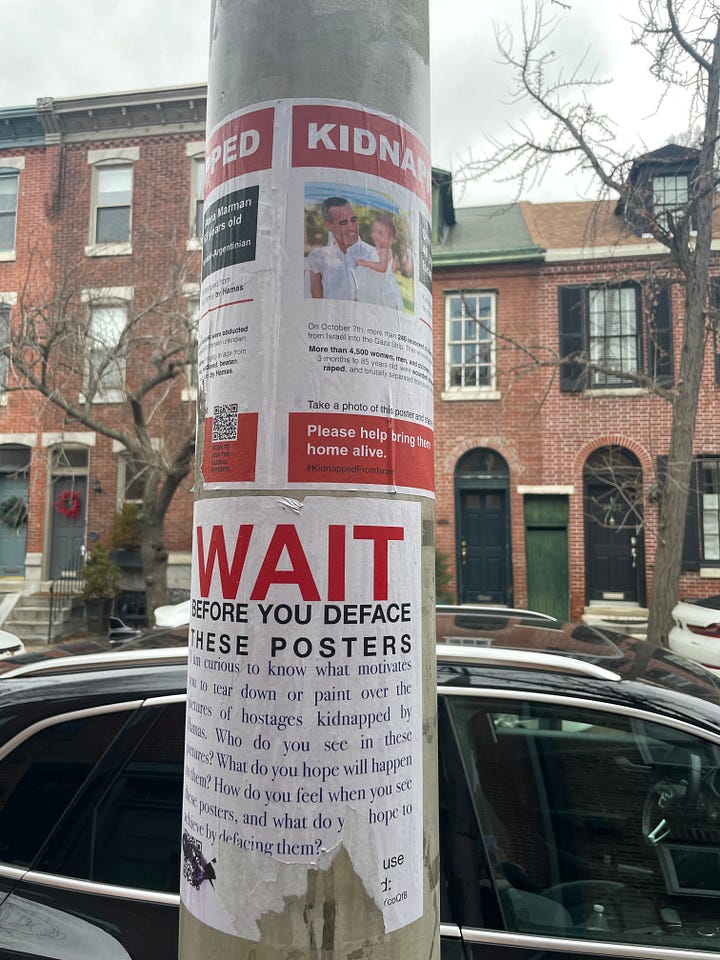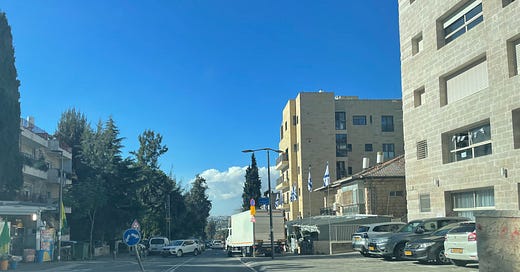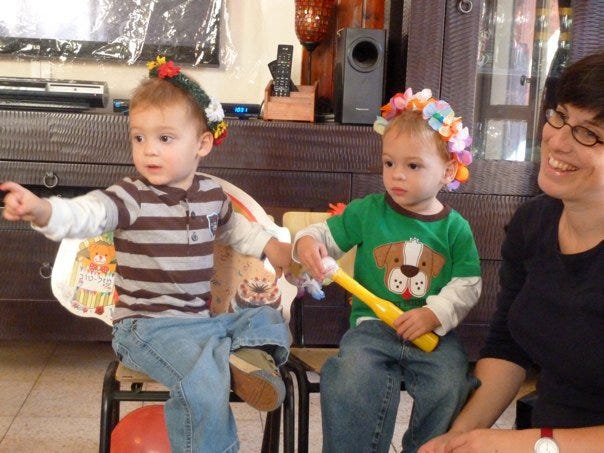It’s been a couple of weeks since I last posted here. I was in the US on a quick speaking tour, talking to communities and schools and synagogues in Philly, Baltimore, New Jersey and New York about what I’ve been reporting on since October 7, about the hostages and the hostage families and the bereaved parents and their stories, and volunteer farming and reservists’ mustaches, among other things.
It was also an opportunity to see and talk to people, to hear what they’re thinking about, what life has been like for them over the last four months. What life has been like for all of us. I heard from friends who are academics, dealing with fallout regarding the IDF’s incursions into Gaza, from friend’s kids who are having a rough time on campuses, and others who are feeling it much less so.
And I kept on marveling to myself how much more ‘normal’ everything felt in the US. To be expected, of course, and it was a welcome change even as it felt strange to be missing that heavy veil of mourning that seems to blanket everything back home. I kept checking my phone so as to not miss anything that was happening, but with the difference in time I felt like I couldn’t help but take a break, and separate myself a little from the realities of the last four months.


There were reminders, of course. A walk down a Philly street showed lampposts plastered with pictures of hostages, and underneath, another sticker imploring passersby not to rip them off. “Wait, before you deface these posters,” it said, in caps and red letters.
In New York’s Upper West Side, I was walking down Broadway past what was once Filene’s Basement and maybe DSW after that? The windows of that corner store were plastered with hostage posters, row after row of the same faces. Then I watched passersby stop and look and try to figure out what they were seeing.
In suburban New Jersey, some houses had placards on their lawns that said, “Ceasefire Now!” — looking for a cessation of battle in Gaza, but no pictures of hostages.
My younger audiences had lots of questions: Does it make me sad to speak to people who are so sad? Can I go for walks outside? What’s the happiest story I’ve written in the last few months?
The older audiences also had questions: How do I take care of my mental health? Should they still be reading The New York Times? (Yes.) What can they do for Israel? Do Israelis know what’s happening in Gaza? (Yes.)
Some questions were harder than others but for the most part, these were pro-Israel audiences, people as shocked as I was by October 7.
When I got home, to the news that David Shkury, son of our local makolet (corner store) owner, Sasson, had been killed in battle, I realized that what I didn’t tell some of those audiences was the sense of mourning that is so prevalent around Israel. My plane landed and that was the first message I saw on WhatsApp, being passed around my family and friends and a few neighborhood groups as people planned to stand outside their building with Israeli flags, sending them off with respect and affection as the Shkurys buried their son.
It was the first of two funerals that week in our Talpiot neighborhood, where there have been several others over the last months. This one hit hard because Sasson Shkury, the dad, is the co-owner with his brother of the popular makolet on Ein Gedi Street, the one with flower boxes outside and everything you could possibly need along its meandering aisles. There’s plenty of fresh produce, several brands of ice cream, bags of fresh pita, flowers on Friday, baked goods, shelves of Israeli wine and liquor, a full array of American candy and chocolate alongside the usual dairy products, canned goods, cereal and every kind of flour.
Gaby, Sasson’s wife and David’s mother, once ran a small pre-school in their apartment above the market, and we sent our boys, Ziv and Lev, to her when they were two years old. It was my first experience sending my first and only children out of the house, and it was a soft landing. Gaby is South American, warm and caring, and had about five little ones from the morning into the early afternoon and that time included a two-hour nap.
The boys learned to eat cold cereal there, along with ptitim, tiny balls of toasted pasta, as well as their first Hebrew songs and, let’s be honest, it was their first Hebrew-speaking environment despite being born here.
We would walk them up the staircase situated in a hallway in the middle of the store, every day, and back down every afternoon. It was only for one year, probably about ten months in total, but ever since, Sasson calls us “Ziv and Lev’s parents,” whenever one of us is in the store, which is often.
Last Wednesday, as they were burying their son, an army-hired team set up a tent in the small parking lot of the apartment building next door, to be used, I found out later, by the Shkury’s daughter-in-law, who is now a young widow with a baby. There were stacks of white plastic chairs sitting on the flatbed truck and Israeli flags had been set outside on the sidewalk.
Yesterday, we went to pay a shiva call, walking up those stairs, passing by so many other familiar faces and neighbors. A box of bananas at the bottom of the stairs had a handwritten sign with an arrow posted on it, “This way to the Shkury shiva.”
I hadn’t been in those rooms since Ziv and Lev were two, about 13 years ago but the apartment looked the same. I held both of Sasson’s hands, and he said, “Ziv and Lev’s ima and abba.” I don’t think Gaby remembered us, she probably had so many parents over the years, and we were just two of them. She just said, and we echoed her, “There are no words,” because there really aren’t any.
We walked back down and outside, past the mourning tent full of people and Daniel and I talked about how does one go on after a loss like this, what does that even look like. And we went home, taking one of the walks that I’d spoken about with a class of fifth graders in Philadelphia, albeit a walk that both comforts and brings up all kinds of thoughts.
And then, we all woke up this morning to the unbelievably joyous news about the rescue of hostages Luis Har and Fernando Marman, who had been taken from Nachal Yitzchak, alongside the deaths of two soldiers who fought in Gaza.
Highs and lows, ups and downs, one foot in front of the other. And then I set off to Haifa, to see some new exhibits at the Haifa Museum of Art. Life does go on, but more readily for some than others.






thanks, carrie. missed seeing you too, but yep, we plan on being there....love to the whole crew.
You write so descriptively that I feel all the emotions that you experienced as if I was right there with you. I’ve been sick and could not keep up with news but I’m exhausted hearing about your trip, all the presentations you gave and questions you answered. Then upon your return the , mitzvot you performed to support friends/family and fast return to your work responsibilities and family is beyond exhausting as I sit in my apt trying to stay awake after microwaving precooked food brought to
me for lunch.
You are an amazing, talented and deeply caring young woman with many talents and strengths. You are an asset to your family, community and your work. Thank you for your writing talents that are so poignant and expressive.
With much admiration and love , stay well and be safe ! Love Ruth